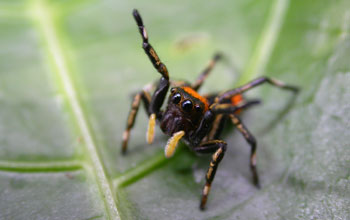Multimedia Gallery
Adult female jumping mimics the waving antennae of velvet ants
An adult female jumping spider (Phiale mimica) from the rainforest of La Selva Biological Station in Costa Rica. The spider is seen here waving her front legs, presumably mimicking the waving antennae of a velvet ant (probably of the genus Dasymutilla). Velvet ants are actually wingless wasps and have a painful sting, so mimicking them gives the spider protection from predators.
More about this Image
As part of her dissertation research, supported by a U.S. National Science Foundation Graduate Research Fellowship, Lisa Taylor of Arizona State University studied mimicry in the jumping spider family Salticidae. Salticidae are the largest family of jumping spiders in the world.
In biology, mimicry is the similarity of one species to another and may offer protection from predators for one or both of the species involved. The mimicking species may be similar to the mimicked in appearance, behavior, sound, scent and location. (Date of Image: 2005-2010)
Credit: Lisa Taylor, Arizona State University
See other images like this on your iPhone or iPad download NSF Science Zone on the Apple App Store.
Images and other media in the National Science Foundation Multimedia Gallery are available for use in print and electronic material by NSF employees, members of the media, university staff, teachers and the general public. All media in the gallery are intended for personal, educational and nonprofit/non-commercial use only.
Images credited to the National Science Foundation, a federal agency, are in the public domain. The images were created by employees of the United States Government as part of their official duties or prepared by contractors as "works for hire" for NSF. You may freely use NSF-credited images and, at your discretion, credit NSF with a "Courtesy: National Science Foundation" notation.
Additional information about general usage can be found in Conditions.
Also Available:
Download the high-resolution JPG version of the image. (2 MB)
Use your mouse to right-click (Mac users may need to Ctrl-click) the link above and choose the option that will save the file or target to your computer.



